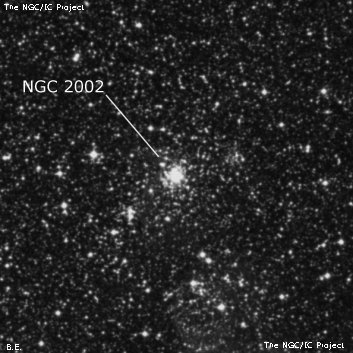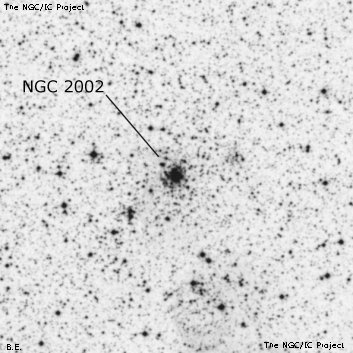NGC/IC Project Restoration Effort
(This is a very very beta version)
NGC2002


Basic Information
Location and Magnitude
Right Ascension: 5:30:20.4
Declination: -66:53:3
Constellation: DOR
Visual Magnitude: 10.1
Historic Information
Discoverer: Dunlop
Year of discovery: 1826
Discovery aperture: 9.0
Observational
Summary description: vB, S, R, ** + neb in vLCl
Sub-type: OCL
Corwin's Notes
=====
NGC 2002. JH has two observations of this. The positions agree to within his
usual errors (~2 arcmin), but the descriptions are very different:
Sweep 658 on 20 Dec 1835: "Place of a double star class I, (h 3779), the
chief of a great cluster of S sts loose and filling the field. It is the
forerunner of the great cluster-region of the nubecula.
Sweep 760 on 2 Jan 1837: "vB, S, R. Here comes on the richest and
brightest part of the starry and clustering protion of the nubecula. (Note.
-- From this object being described at one time as a double star, and at
another as a nebula, it is probable that it is in one of those singular
close-knotted groups which especially characterize the nubeculae.)
The position lies close to the globular cluster that nearly everyone has taken
as NGC 2002, but the differing descriptions lead me to question that classical
identification. In particular, JH's first observation makes the double the
brightest star in a star cloud that I make 18' x 11' centered a couple of
arcminutes north of the cluster. The star cloud almost sweeps southeast to
encompass as well the two clusters of NGC 2006 (which see.) For the record, I
also checked the double star h 3779, and found the two stars, magnitudes 10
and 12, to be separated by only 2 arcsec in PA 343.5. The field is crowded,
but there is nothing obvious that close together. So, the two stars are
probably in the core of the cluster itself, overexposed on the sky survey
images.
JH's second observation clearly points to the cluster, and describes it very
well -- he saw many other LMC clusters as small, bright, unresolved nebulae.
Given the dicotomy, I've put two objects into the main table, each
corresponding to one of JH's observations. This may not be an ideal
situation, but given the nature of what JH described, I feel I have little
choice.
Steve's Notes
=====
NGC 2002
24" (4/7/08 - Magellan Observatory, Australia): at 200x this cluster is extremely bright but small. It is sharply concentrated with a small, brilliant core surrounded by a much fainter 30" halo. At 346x, the core diameter is ~15" diameter and three interior stars are resolved, the brightest on the southeast side. Sharing the same field 8' SE is the double cluster NGC 2006 and S-L 538. NGC 2002 is at the west end of a huge, arcing string of associations (bowed to the south) referred to as LH 77 or the "Quadrant", which extends nearly 40' to the east beyond NGC 2041.



